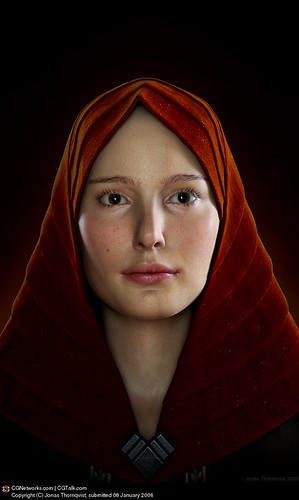Uncanny Valley

Believe it or not, this image is entirely generated on a computer, using 3D Studio Max, Zbrush and Photoshop, three powerful CGI (Computer Generated Imagery) software packages, and the amazing talent of Jonas Thornqvist [Link] (original story from Digg). The entire face - wispy eyebrows, pouty lips, rough complexion, deliberately squinted eyes, unsymmetric facial features - all add to a sense of realism atypical of CGI images. Curiously, he avoided showing her hair - which is usually the hardest facial element to render realistically. The end result looks eerily like Natalie Portman (real life photo here)!
 Equally breathtaking images can be seen on the CG Society website. A few of my favorite photo-realistic images are: Pu Yi [Link], Batman [Link] and Morpheus [Link]. Not real, but close: Angel [Link], Knight of the Temple [Link], Octopus [Link] and Monica Belluci [Link].
Equally breathtaking images can be seen on the CG Society website. A few of my favorite photo-realistic images are: Pu Yi [Link], Batman [Link] and Morpheus [Link]. Not real, but close: Angel [Link], Knight of the Temple [Link], Octopus [Link] and Monica Belluci [Link].
This ever-increasing realism of computer generated images is clearly visible in recent Hollywood movies - from The Incredibles to Final Fantasy to Simone (or, rather S1m0ne). In parallel, robot development has also been evolving, from the Biped Rabbit Robot [Link] to consumer-oriented playmates like Sony's Aibo [Link].
Social roboticists have been theorizing about the emotional response of humans to near-human entities for a long time. Masahiro Mori, a Japanese roboticist, proposed the Uncanny Valley Principle in 1970 [Link].
"The Uncanny Valley is a principle of robotics concerning the emotional response of humans to robots and other non-human entities. The principle states that as a robot is made more humanlike in its appearance and motion, the emotional response from a human being to the robot will become increasingly positive and empathic, until a point is reached at which the response suddenly becomes strongly repulsive; as the appearance and motion are made to be indistinguishable to that of human being, the emotional response becomes positive once more and approaches human-human empathy levels. This gap of repulsive response aroused by a robot with appearance and motion between a "barely-human" and "fully human" entity is called the Uncanny Valley.
The phenomenon can be explained by the notion that if an entity is sufficiently non-humanlike, then the humanlike characteristics will tend to stand out and be noticed easily, generating empathy. On the other hand, if the entity is "almost human", then the non-human characteristics will be the ones that stand out, leading to a feeling of "strangeness" in the human viewer."
In other words, the "Uncanny Valley" theory states (roughly) that when an artificial object is very similar in appearance to a human we will fixate on the parts that make it look "not human" and this will generate a negative response in us. Reminds me of my performance reviews at work, since I'm so perfect, the reviewers have to focus on traits that make me non-human, and this generates negative responses on my assessment. That explains my low raise last year!
If the Uncanny Valley concept seems abstract, here is an example:
Some prosthetic hands attempt to simulate veins, muscles, tendons, finger nails, and finger prints, and their color resembles human pigmentation. So maybe the prosthetic arm has achieved a degree of human verisimilitude on par with false teeth. But this kind of prosthetic hand is too real and when we notice it is prosthetic, we have a sense of strangeness. So if we shake the hand, we are surprised by the lack of soft tissue and cold temperature. In this case, there is no longer a sense of familiarity. It is uncanny.
Sara Kiesler [Bio], a human-robot interaction researcher at Carnegie Mellon University, first suggested that conflicting evidence for human likeness from a humanlike entity may elicit the same terror management defences that reminders of death do. In other words, humans may be subconsciously reminded of their mortal nature when they see near-human characteristics. So they fixate on distancing these near-human objects from themselves through a negative emotional response. See Karl MacDorman's research paper (presented at the Andriod Science 2005 workshop) for more details [PDF]. This is a plausible theory, and MacDorman has done some perceptual research to test this claim, but I feel that the link is tenuous, certainly not provably causal.
As an aside, I took an HCI class with Sara at CMU - a fun course on interface design. She was involved in the HCI institute project that designed early versions of the Palm V (the T-Rex that ruled the consumer electronics earth before the iPods meteors hit).
For more of Masahiro Mori's work on Uncanny Valley, including the effect of movement on our perception, see here.






Nice site!
[url=http://aerrxpbe.com/ayjr/rrga.html]My homepage[/url] | [url=http://bafrnfbw.com/ryoj/kcsa.html]Cool site[/url]
Posted by Anonymous |
10:24 AM EDT ·
Anonymous |
10:24 AM EDT ·
Well done!
http://aerrxpbe.com/ayjr/rrga.html | http://hlhgvtbk.com/aiqf/tcty.html
Posted by Anonymous |
10:25 AM EDT ·
Anonymous |
10:25 AM EDT ·